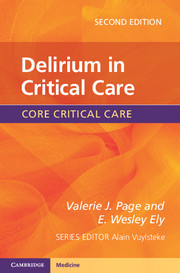61 results
Use of the brief Confusion Assessment Method in a veteran palliative care population: A pilot validation study
-
- Journal:
- Palliative & Supportive Care / Volume 17 / Issue 5 / October 2019
- Published online by Cambridge University Press:
- 19 March 2019, pp. 569-573
-
- Article
- Export citation
Delirium etiology subtypes and their effect on six-month function and cognition in older emergency department patients
-
- Journal:
- International Psychogeriatrics / Volume 31 / Issue 2 / February 2019
- Published online by Cambridge University Press:
- 19 July 2018, pp. 267-276
-
- Article
- Export citation
Chapter 9 - Treatment of delirium in critical care
-
- Book:
- Delirium in Critical Care
- Published online:
- 05 April 2015
- Print publication:
- 12 March 2015, pp 157-185
-
- Chapter
- Export citation
Chapter 10 - Mental capacity and restraints
-
- Book:
- Delirium in Critical Care
- Published online:
- 05 April 2015
- Print publication:
- 12 March 2015, pp 186-196
-
- Chapter
- Export citation
Chapter 3 - What does delirium look like in critical care?
-
- Book:
- Delirium in Critical Care
- Published online:
- 05 April 2015
- Print publication:
- 12 March 2015, pp 27-43
-
- Chapter
- Export citation
Index
-
- Book:
- Delirium in Critical Care
- Published online:
- 05 April 2015
- Print publication:
- 12 March 2015, pp 216-228
-
- Chapter
- Export citation

Delirium in Critical Care
-
- Published online:
- 05 April 2015
- Print publication:
- 12 March 2015
Chapter 12 - What is the future?
-
- Book:
- Delirium in Critical Care
- Published online:
- 05 April 2015
- Print publication:
- 12 March 2015, pp 208-213
-
- Chapter
- Export citation
Delirium, a patient testimony
-
- Book:
- Delirium in Critical Care
- Published online:
- 05 April 2015
- Print publication:
- 12 March 2015, pp xiv-xviii
-
- Chapter
- Export citation
Dedication
-
- Book:
- Delirium in Critical Care
- Published online:
- 05 April 2015
- Print publication:
- 12 March 2015, pp v-vi
-
- Chapter
- Export citation
Chapter 7 - Delirium in critical care: monitoring tools
-
- Book:
- Delirium in Critical Care
- Published online:
- 05 April 2015
- Print publication:
- 12 March 2015, pp 109-139
-
- Chapter
- Export citation
Chapter 8 - How to prevent delirium?
-
- Book:
- Delirium in Critical Care
- Published online:
- 05 April 2015
- Print publication:
- 12 March 2015, pp 140-156
-
- Chapter
- Export citation
Series page
-
- Book:
- Delirium in Critical Care
- Published online:
- 05 April 2015
- Print publication:
- 12 March 2015, pp ii-ii
-
- Chapter
- Export citation
Chapter 4 - Delirium in critical care: how does it happen?
-
- Book:
- Delirium in Critical Care
- Published online:
- 05 April 2015
- Print publication:
- 12 March 2015, pp 44-67
-
- Chapter
- Export citation
Chapter 6 - Delirium in critical care: why is it important?
-
- Book:
- Delirium in Critical Care
- Published online:
- 05 April 2015
- Print publication:
- 12 March 2015, pp 94-108
-
- Chapter
- Export citation
Delirium in Critical Care - Half title page
-
- Book:
- Delirium in Critical Care
- Published online:
- 05 April 2015
- Print publication:
- 12 March 2015, pp i-i
-
- Chapter
- Export citation
Contents
-
- Book:
- Delirium in Critical Care
- Published online:
- 05 April 2015
- Print publication:
- 12 March 2015, pp vii-viii
-
- Chapter
- Export citation
Copyright page
-
- Book:
- Delirium in Critical Care
- Published online:
- 05 April 2015
- Print publication:
- 12 March 2015, pp iv-iv
-
- Chapter
- Export citation
Chapter 2 - How common is delirium in critical care?
-
- Book:
- Delirium in Critical Care
- Published online:
- 05 April 2015
- Print publication:
- 12 March 2015, pp 14-26
-
- Chapter
- Export citation
Chapter 1 - What is delirium in critical care?
-
- Book:
- Delirium in Critical Care
- Published online:
- 05 April 2015
- Print publication:
- 12 March 2015, pp 1-13
-
- Chapter
- Export citation



